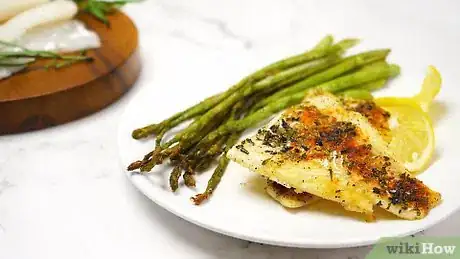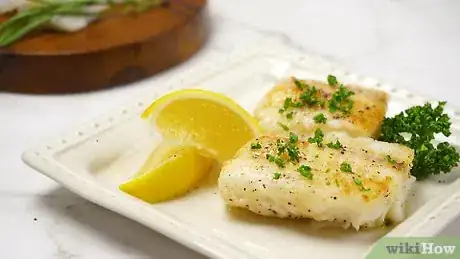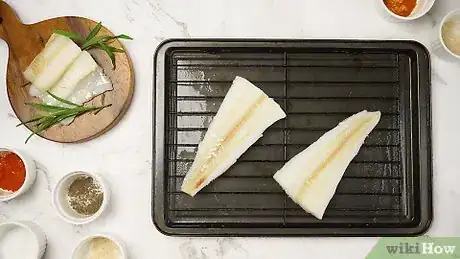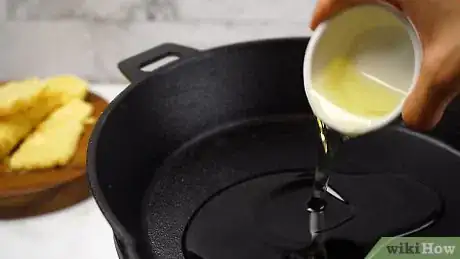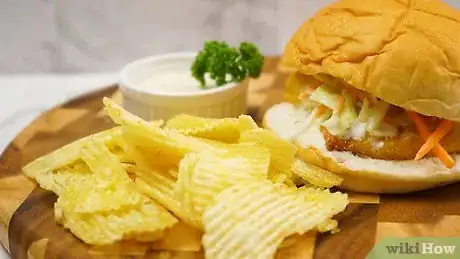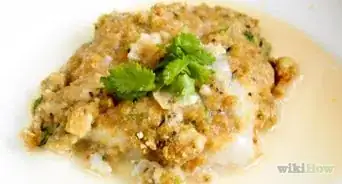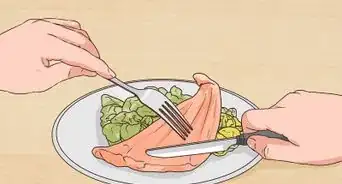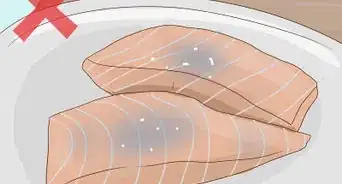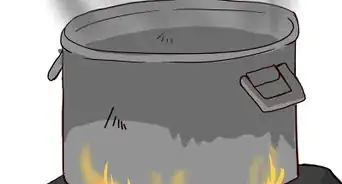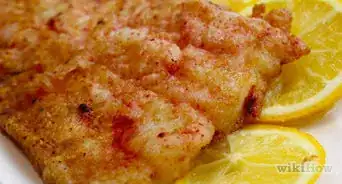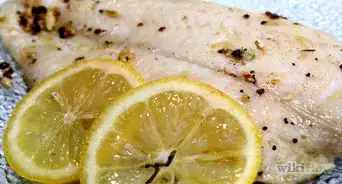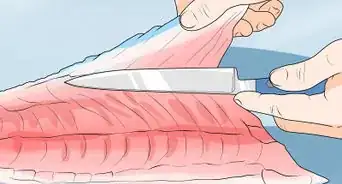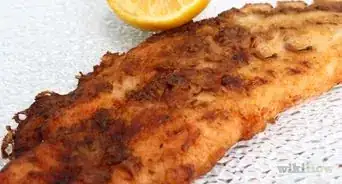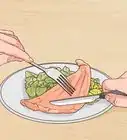This article was co-authored by wikiHow Staff. Our trained team of editors and researchers validate articles for accuracy and comprehensiveness. wikiHow's Content Management Team carefully monitors the work from our editorial staff to ensure that each article is backed by trusted research and meets our high quality standards.
There are 9 references cited in this article, which can be found at the bottom of the page.
The wikiHow Culinary Team also followed the article's instructions and verified that they work.
This article has been viewed 49,477 times.
Learn more...
Haddock is a delicious light and flaky white fish that’s also super easy to cook. Because it’s so delicate, whether you bake it, sear it, or fry it, handle the haddock with care and avoid overcooking it so it doesn’t take on a rubbery texture. With a few simple ingredients, you can cook your haddock a variety of tasty ways.
Ingredients
- 2 pounds (0.91 kg) of haddock filets
- 3 tablespoons (44 mL) of melted butter
- ¼ (.58 g) of black pepper
- ⅓ teaspoon (2 g) of salt
- 1⁄2 teaspoon (2.5 mL) of lemon juice
- 2 minced garlic cloves
- ½ teaspoon (.27 g) of parsley
- ¾ teaspoon (.45 g) of crushed tarragon
- ½ teaspoon (1.15 g) of paprika
- Haddock filets
- Salt
- Pepper
- 2 tablespoons (30 mL) olive oil or butter
- Lemon wedge or capers to garnish (optional)
- 2 pounds (0.91 kg) of haddock filets
- ½ teaspoon (1.2 g) of onion powder
- ½ teaspoon (1.15 g) of paprika
- ½ teaspoon (1.64 g) of garlic powder
- ½ teaspoon (1.17 g) of ground black pepper
- ½ teaspoon (3 g) of salt
- ¼ teaspoon (.9 g) of cayenne pepper
- 1 tablespoon (14.2 g) of butter, cut into small pieces
- 1 lemon, cut into wedges
- Haddock filets
- Canola oil
- ¼ teaspoon (.58 g) of paprika
- 2 cups (320 g) of cornmeal
- Black pepper
- 1⁄2 cup (120 mL) of milk
- 1⁄2 cup (120 mL) of buttermilk
- Buns or rolls
- Tartar sauce
- Coleslaw
- Pickles
Steps
Lemon and Garlic Baked Haddock
-
1Preheat your oven to 350 °F (177 °C). Get your oven ready to go by turning it on while you get started preparing your haddock. Set it to your cooking temperature and allow it to fully heat up.[1]
- Most ovens will beep or make a sound to indicate that it’s ready.
-
2Spray a baking dish with non-stick spray. Choose a baking tray or sheet that will hold all of your haddock filets in a single layer so they cook evenly. Coat the baking dish with non-stick cooking spray so your filets to stick to the surface.[2]
- If you don’t have non-stick spray, you can lightly brush olive oil on the surface of the baking dish.
- Haddock is a delicate white fish, so it can easily stick to a pan and fall apart.
Advertisement -
3Place the haddock in the baking dish and sprinkle with salt and pepper. Take your filets and place them at the bottom of the dish. Place them next to each other lined up in the same direction to form an even layer that will cook consistently.[3]
- Don’t stack the filets or they may not cook consistently. Use another baking dish if you don’t have room to fit them all.
-
4Melt the butter in a bowl and add the lemon juice and garlic. Place your butter in a microwave-safe bowl and microwave it for about 30-45 seconds until it’s fully melted.[4] Then, add 1⁄2 teaspoon (2.5 mL) of lemon juice and 2 minced garlic cloves into the bowl and stir it to combine them.[5]
- Keep an eye on the butter as it melts so it doesn’t smoke or burn. As soon as it’s melted, it’s good to go.
-
5Brush the mixture evenly over the haddock. Use a kitchen brush to spread the mixture over the haddock filets in the baking dish. Coat all of the filets evenly and use all of the buttery mixture.[6]
- If you don’t have a kitchen brush, carefully pour the mixture over the fillets.
- The buttery mixture will also help keep the fish from sticking to the dish.
-
6Sprinkle the parsley, tarragon, and paprika over the fish. Take ½ teaspoon (.27 g) of parsley and sprinkle it over all of the filets, then add ¾ teaspoon (.45 g) of crushed tarragon. Carefully sprinkle ½ teaspoon (1.15 g) of paprika over the haddock so it’s distributed evenly for a touch of heat.[7]
-
7Bake the haddock for 25 minutes until it’s flaky. Slide the baking dish onto the center rack of your oven. Set a timer for 25 minutes and leave the fish undisturbed to cook. When it’s done, take it out and use a fork to make sure it’s nice and flaky before you serve it.[8]
- Use the center rack so the convection cooks the haddock evenly.
- If the fish isn’t flaky, put it back in your oven for another 2-3 minutes.
Pan-Seared Haddock
-
1Pat the haddock dry and sprinkle with salt and pepper. Use paper towels to pat down the haddock so they’re dry. Sprinkle some salt and black pepper over the top of the filets.[9]
-
2Heat the olive oil in a skillet on medium-high heat. Place a skillet on a burner set to medium-high heat on your stovetop. Carefully add 2 tablespoons (30 mL) of olive oil to the pan and wait until it starts to produce a small amount of smoke to know that it’s heated.[10]
- Olive oil can burn, so don’t let it smoke for too long before you add your fish.
- You could also use 2 tablespoons (30 mL) of butter instead of olive oil.
-
3Place the haddock in the pan with the seasoned side down. Gently pick up a haddock filet and carefully place it in the hot pan with the seasoned side facing down. Add the rest of the filets into the pan the same way without stacking them so they cook evenly.[11]
- If you can’t fit all of the haddock in the pan, cook them in batches.
- The hot oil can splash up and burn your hands so add the haddock carefully into the pan.
-
4Season the other side with salt and pepper and let it cook for 2-3 minutes. Sprinkle the salt and pepper over the non-seasoned sides of the haddock as it cooks in the pan. Allow the filets to sear and cook for a few minutes.[12]
- Because haddock is so delicate, it doesn’t take too long to cook in a hot pan.
-
5Flip the haddock and let it cook for another 2-3 minutes. After a few minutes, use a flat spatula to carefully flip the haddock so the other side can cook. Flip all of the haddock filets in the pan and let the other side sear.[13]
- The sear gives the fish a nice color and flavor.
-
6Remove the fish from the skillet and serve it hot. Once the filets are cooked, take them out of the pan. Add them to plates and serve the haddock while it’s still hot.[14]
- You can garnish the filets with fresh lemon wedges or capers if you like.
- Store any leftovers in an airtight container in your refrigerator for up to a week.
Simple Broiled Haddock
-
1Place the top oven rack 6 inches (15 cm) and turn on the broiler. Make sure the uppermost oven rack is close to your broiler. Turn on the broiler so it’s ready to go when your haddock filets are prepared.[15]
-
2Arrange the haddock filets on a greased broiler pan. Take a flat broiler pan and spray it with cooking spray to keep the filets from sticking to it. Place your haddock filets on the pan in a single layer so they cook consistently.[16]
- If you don’t have a broiler pan, use a baking sheet lined with tin foil.
-
3Mix the seasonings and sprinkle them over the haddock. Take a small bowl and add the onion powder, paprika, garlic powder, black pepper, salt, and cayenne pepper. Stir the seasonings well to combine them, then sprinkle the seasoning over the haddock filets.[17]
- Cover the filets evenly with the seasoning.
-
4Put the pieces of butter on the haddock filets. Take the small pieces of butter and dot the filets with them. Distribute the pieces of butter evenly over the filets so they melt under the broiler.[18]
- The butter will infuse the filets with more flavor.
-
5Broil the haddock for 6-8 minutes then serve it with a lemon garnish. Place the broiler pan on the rack beneath the broiler. Wait until the fish is white and flaky, which takes about 6-8 minutes, then remove the pan from the oven. Garnish the haddock with a lemon wedge and serve it while it’s hot.[19]
- If you have any leftovers put them in an airtight container in your fridge. They should be good for up to a week.
Breaded and Fried Haddock
-
1Heat canola oil in a cast-iron pan over high heat. Use a cast-iron skillet, which can handle higher temperatures than other pans. Add about 3–4 tablespoons (44–59 mL) of canola oil so you have enough to fully cover the bottom of the pan and fry up your haddock.[20]
- Use canola oil or vegetable oil, which has a higher smoke point than olive oil or butter and is better for frying.
-
2Combine the cornmeal, paprika, and pepper in a bowl. Take a medium-sized bowl and add 2 cups (470 mL) of cornmeal, 1⁄4 teaspoon (1.2 mL) of paprika, and a pinch of black pepper. Stir the ingredients so they’re fully combined into a batter mixture.[21]
- If you don’t have cornmeal, you can use regular flour instead.
-
3Fill another bowl with the milk and buttermilk. Take another clean bowl and pour 1⁄2 cup (120 mL) of buttermilk and 1⁄2 cup (120 mL) of regular milk. Stir the contents together to combine them.[22]
- Buttermilk has a higher fat content and will help the cornmeal batter stick to the fish.
-
4Dredge the haddock in the milk and cornmeal mixtures. Take a haddock filet and dip it into the milk mixture so both sides are coated. Then, place it in the bowl of cornmeal and flip it over so both sides are covered with the batter. Use your fingers to sprinkle the cornmeal batter over any exposed areas of the fish so it’s fully covered. Dredge the rest of the filets the same way.[23]
-
5Fry the haddock in the skillet for 2 minutes on each side. Carefully place the battered haddock filet into the hot oil in the skillet. Allow it to cook for about 2 minutes, then flip it over with a flat spatula so the other side can cook.[24]
- Fry up all of the filets for the same amount of time on each side.
-
6Place the fish on a bun with tartar sauce, coleslaw, and pickles. Use a roll, sliced bread, or a bun for your haddock sandwich. Place the cooked filet on the bun and add some tartar sauce, coleslaw, and crunch pickles as condiments.[25]
- Enjoy the sandwich with some tasty chips or french fries.
- The fish filets can be stored for up to a week in an airtight container in your fridge.
Warnings
- Be careful not to burn yourself when if you’re cooking with hot oil.⧼thumbs_response⧽
- Never use water to put out a flame in hot oil or you could start a fire.⧼thumbs_response⧽
References
- ↑ https://www.foodnetwork.com/recipes/baked-haddock-ellida-style-recipe-1939839
- ↑ https://www.foodnetwork.com/recipes/baked-haddock-ellida-style-recipe-1939839
- ↑ https://www.food.com/recipe/baked-haddock-155017
- ↑ https://www.bhg.com/recipes/how-to/cooking-basics/how-to-melt-butter/
- ↑ https://www.food.com/recipe/baked-haddock-155017
- ↑ https://www.food.com/recipe/baked-haddock-155017
- ↑ https://www.food.com/recipe/baked-haddock-155017
- ↑ https://www.foodnetwork.com/recipes/baked-haddock-ellida-style-recipe-1939839
- ↑ https://www.thekitchn.com/how-to-cook-fish-on-the-stovetop-cooking-lessons-from-the-kitchn-204805
- ↑ https://www.food.com/recipe/pan-seared-haddock-58511
- ↑ https://www.thekitchn.com/how-to-cook-fish-on-the-stovetop-cooking-lessons-from-the-kitchn-204805
- ↑ https://www.thekitchn.com/how-to-cook-fish-on-the-stovetop-cooking-lessons-from-the-kitchn-204805
- ↑ https://www.thekitchn.com/how-to-cook-fish-on-the-stovetop-cooking-lessons-from-the-kitchn-204805
- ↑ https://www.thekitchn.com/how-to-cook-fish-on-the-stovetop-cooking-lessons-from-the-kitchn-204805
- ↑ https://www.allrecipes.com/recipe/232906/simple-broiled-haddock/
- ↑ https://www.food.com/recipe/broiled-haddock-fillets-35054
- ↑ https://www.allrecipes.com/recipe/232906/simple-broiled-haddock/
- ↑ https://www.allrecipes.com/recipe/232906/simple-broiled-haddock/
- ↑ https://www.allrecipes.com/recipe/232906/simple-broiled-haddock/
- ↑ https://www.foodnetwork.com/recipes/grilled-haddock-roll-3536515
- ↑ https://www.foodnetwork.com/recipes/grilled-haddock-roll-3536515
- ↑ https://www.foodnetwork.com/recipes/haddock-fish-sandwich-3032404
- ↑ https://www.foodnetwork.com/recipes/grilled-haddock-roll-3536515
- ↑ https://www.foodnetwork.com/recipes/grilled-haddock-roll-3536515
- ↑ https://www.foodnetwork.com/recipes/haddock-fish-sandwich-3032404
About This Article
Lemon and garlic baked haddock is delicious and easy to make. Coat the inside of a baking dish with non-stick spray or olive oil, and place the filets in a single layer inside of it. Season them with salt and pepper. In a small bowl, mix melted butter, lemon juice, and garlic. Brush the mixture over the seasoned filets, then sprinkle on some parsley, tarragon, and paprika. Bake the haddock for 25 minutes at 350 degrees Fahrenheit and enjoy! To learn other ways to cook haddock, like pan searing, frying, and broiling it, check out the full article!

